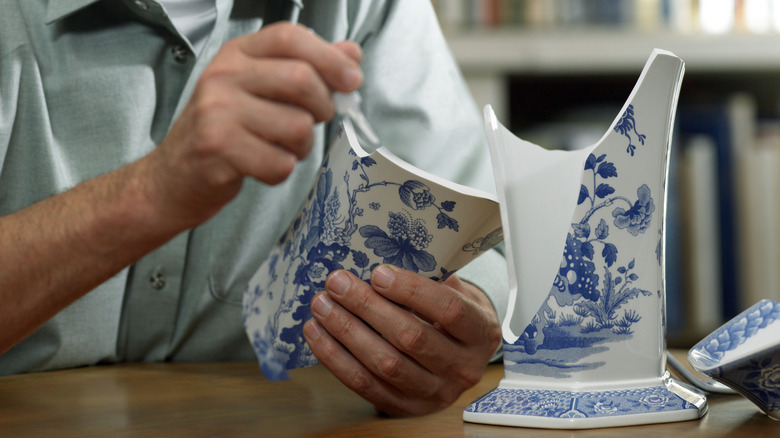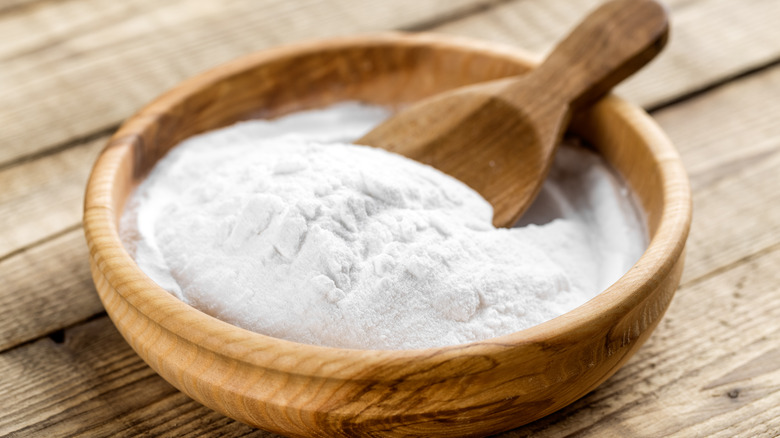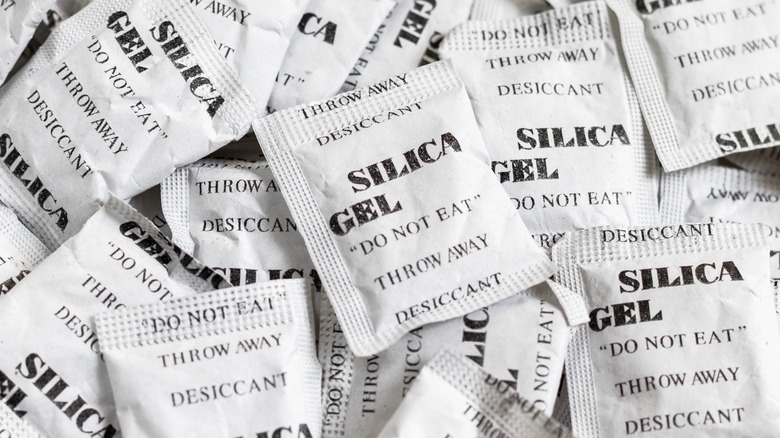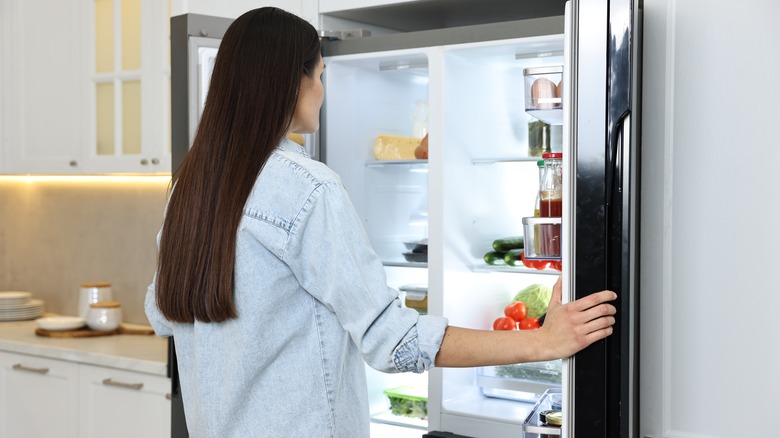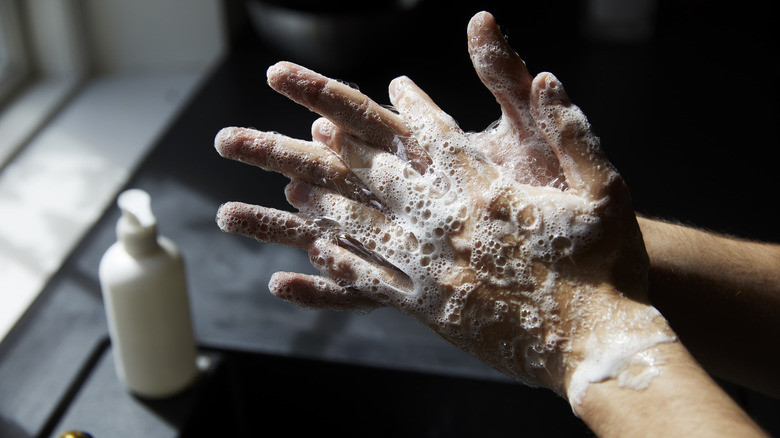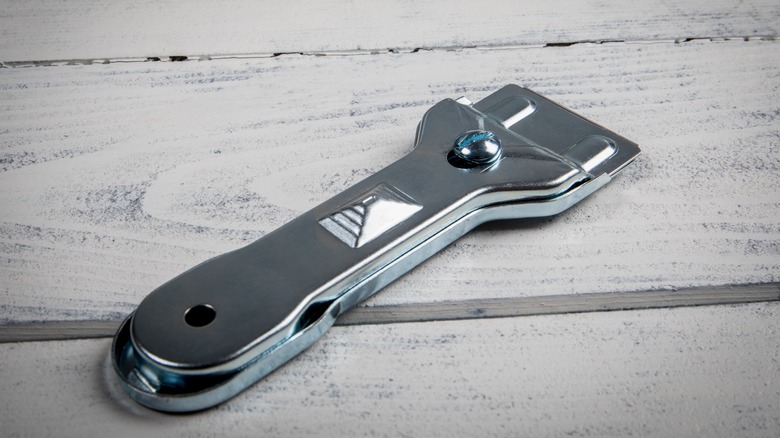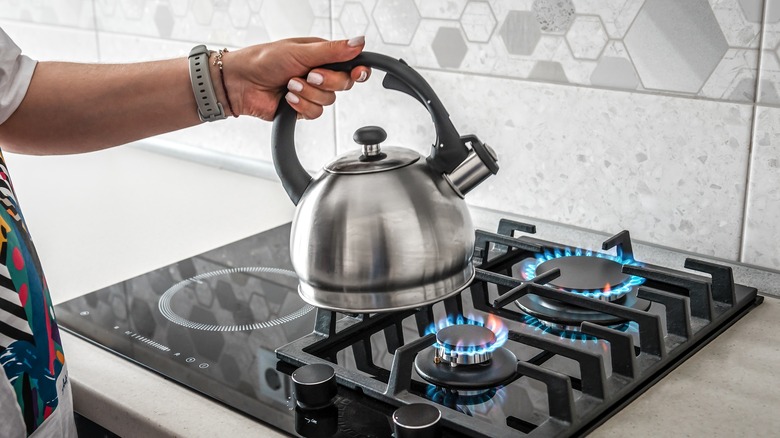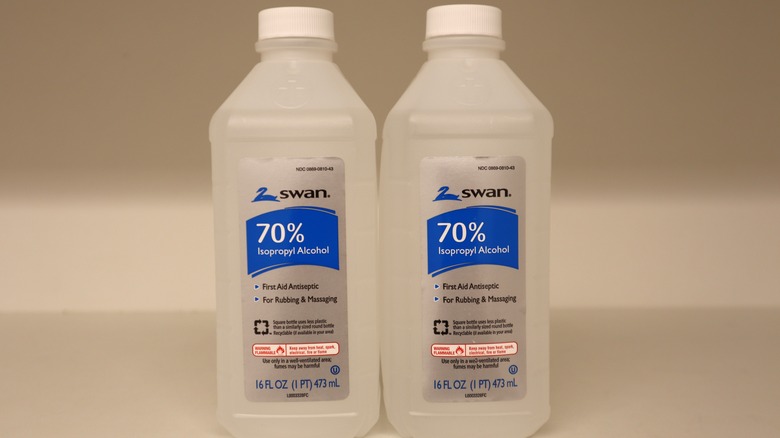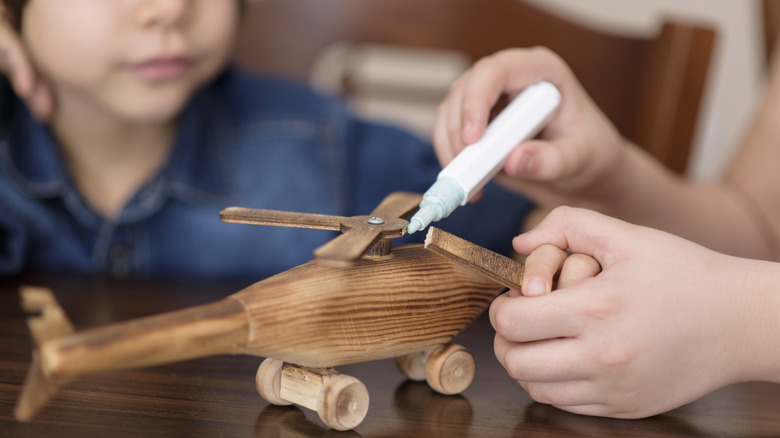9 Genius Super Glue Tips & Tricks You'll Wish You Knew Sooner
We may receive a commission on purchases made from links.
In 1942, while working to produce precision gun sights for World War II soldiers, Harry Coover stumbled upon cyanoacrylate, the miracle adhesive in super glue. In the years since that chance discovery, super glue has become a household staple. You'll find it in the garages, workshops, and craft rooms of hobbyists and DIYers who use it for a plethora of repair jobs and creative activities. The advantages of using super glue for adhesive tasks include its almost instantaneous curing time as well as the strength of the bonds it creates. Additionally, it works on a variety of surfaces, which makes it useful for gluing ceramic, metal, wood, rubber, vinyl, leather, and some plastic materials.
You've probably used super glue many times for small household repairs or creative hobbies. But there are a few tricks that you may not be familiar with. Based on the science behind cyanoacrylate, we've rounded up nine recommendations for using super glue, storing it, and removing it from multiple surface materials. Ahead, you may discover a few facts and pointers that you probably didn't know about this strong adhesive.
Add baking soda to amp up the adhesive effect of super glue
Super glue dries and cures super-fast, forming a strong bond you can count on for a tight connection between materials. That's because cyanoacrylate, the adhesive compound in super glue, is an acrylic monomer that performs a chemical chain reaction, resulting in a powerful bond between surfaces. Typically, this polymerization takes place due to the presence of moisture in the air or on a surface. However, when baking soda (sodium bicarbonate) is present, it jump-starts the polymerization process and makes the bonding process work even faster. The molecules in the sodium bicarbonate react with molecules in the cyanoacrylate compound to form an ion that easily bonds with other cyanoacrylate molecules. This long, polymer chain reaction creates adhesion that is even more secure when baking soda is added to the super glue.
To use baking soda with super glue, simply sprinkle a small amount onto the surface that needs adhesion. Saturate the baking soda with a small amount of super glue, and join the parts you need to connect. It will quickly harden, forming a bond that is even stronger than it would be with super glue alone. A mixture of baking soda and super glue is especially handy when you need to fill gaps or cracks while repairing an item such as a piece of furniture. As an added bonus, the baking soda makes super glue more effective on plastic materials, as well.
Use thin rather than thick layers
For best adhesion results, it only takes one small drop of super glue for each square inch of surface. In fact, applying a thick layer of the glue can actually inhibit the chemical reaction that forms the strong adhesive bond. That's because the cyanoacrylate reacts with moisture in the air or on the surfaces, instantly beginning the curing process. If you lay down a thick blob of super glue, it prevents the atmospheric moisture from reaching all of the cyanoacrylate molecules. This leads to a longer curing time that results in a weaker bond.
Before you apply super glue, prepare the surfaces by wiping them clean to remove dirt, oil, and debris. Although the bonding reaction takes place in the presence of moisture, it is not necessary or advisable to wet the surfaces. In fact, water on the surfaces causes premature bonding so that the glue does not form adequate adhesion. For better adhesion on extremely smooth surfaces, roughing the material with sandpaper may be preferable before gluing. Follow up by wiping away the dust to expose a clean surface. Apply a thin layer of super glue to both of the surfaces that you're gluing together. Then, join the two pieces and hold them together for 15-to-30 seconds.
Store it with silica gel packets to extend its shelf life
Unopened containers of super glue have a shelf life of approximately eight to 12 months. But once you've opened the tube or bottle, the shelf life shortens to several weeks to 12 months, depending on the specific glue product. To extend the shelf life of your glue, you'll want to control its exposure to moisture and temperature extremes. Store an opened container of super glue at temperatures between 50 and 70 degrees Fahrenheit. Due to the fact that moisture initiates the curing process of cyanoacrylate, it's advisable to keep the opened container of super glue as dry as possible. One way to do this is to store the glue in the presence of silica packets.
Silica packets contain silicon dioxide molecules that are capable of absorbing up to 40 percent of their weight in moisture. That's why you'll find the little pouches tucked into the packaging for shoes, handbags, electronics, and many other products. It's easy to save and repurpose a few silica packets from your purchases, or you can order a package of 5-gram silica gel packs from Amazon. To keep your super glue in good condition between projects, place it in a glass jar along with several silica gel packets. Replace the jar lid tightly and store it at room temperature.
Store unopened bottles of super glue in the fridge
While the best way to store an opened bottle of super glue is at room temperature in an airtight jar containing several silica packets, it is possible to extend the shelf life of an unopened tube by keeping it refrigerated. This isn't recommended for opened bottles, though, since it can cause condensation in the tube. However, if you're stocking up on DIY supplies and snag a few extra bottles of super glue on sale, you can save them for future projects by popping them (unopened) into the fridge. Just be sure they're clearly labeled and placed out of the reach of any children in your household.
According to the U. S. Food and Drug Administration, your refrigerator should maintain a temperature between 33 and 40 degrees Fahrenheit. Stored in that temperature range, the cyanoacrylate in super glue will not begin the polymerization process that causes it to harden. When you're ready to use the refrigerated super glue, allow it to warm up to room temperature before you open the cap. Due to being kept dry and cold, the cyanoacrylate should be in a liquid state, ready to bond with surfaces in the presence of moisture at room temperature.
Use regular soap and water to remove it from your skin
One of the most attractive features of super glue is its ability to cure almost instantly in the presence of moisture in the air and on surfaces. But there's even more moisture on your skin, making it super-easy to end up with your fingers glued together or patches of glue stuck to other areas of your body. Don't try to force the affected areas apart, as this could painfully tear your skin. Instead, your first move should be to gently wash the area with warm, soapy water.
If the glue has not yet hardened, the soapy water should wash it off quickly. But super glue cures so fast that you may need to soak your skin in the warm, soapy water for several minutes. Gently scrub the area in a circular motion to loosen the glue. Then, with patience, slowly peel it away. Don't be surprised if you need to repeat these steps several times. If you're in a hurry, you can apply nail polish remover containing acetone to dissolve the glue more quickly. Apply the nail polish remover with a cotton ball and rub gently. Then, wash the area with soapy water and follow up with a moisturizing skin lotion to counter the drying effect of the acetone.
You can simply use a razor blade to remove it from glass
Oops. Super glue cures so fast that it hardens almost immediately wherever it lands. When using super glue on glass and you miss the mark or accidentally get the adhesive on the glass, the best way to remove it is with a razor blade. Due to the fact that cyanoacrylate does not bond well with glass, it's susceptible to being scraped away from glass surfaces. If a fresh application of super glue is difficult to scrape, you can simply wait a few days. The bond between the glue and the glass should degrade over time to facilitate scraping.
When scraping super glue from glass, it's a good idea to protect your fingers using a razor blade scraper like the Stanley razor scraper from The Home Depot. If the glue is especially stubborn, you can loosen it with an application of acetone nail polish remover. Use a cotton ball to transfer the acetone to the glue on the glass surface, saturating the area. Then, proceed to scrape with the razor. As alternatives to acetone, you might try applying methylated spirits, hydrogen peroxide, or lighter fluid. After applying the liquid and scraping with the razor blade, be sure to wash and rinse the glass to remove any residue.
Try using boiling water to remove super glue from metal
Super glue is a miracle adhesive for repairing metal objects because it bonds extremely well with metal. However, this feature makes it difficult to remove from metal surfaces in case of spills or mistakes. Fortunately, metal is impervious to boiling water, and soaking the metal object in boiling water may be all you need to dissolve the glue and remove it without scraping and scratching the metal surface.
If the boiling water does not completely dissolve the glue residue, you might soak the area with either hydrogen peroxide or acetone nail polish remover. Using a cotton ball, press the substance against the glue for about 10 minutes. This should soften the super glue enough for you to wipe it away from the metal surface with a disposable cloth. Alternatively, you might try soaking the metal object for 30 minutes in a mixture of 2 parts water and 1 part white vinegar. Then, rub the area with a rough cloth or a piece of fine-grade sandpaper.
Use rubbing alcohol to remove it from clothes
If you're working on a DIY project and accidentally spill super glue on your clothes, there's no need to despair. You can loosen the glue by blotting the area with rubbing alcohol on a cotton ball. Once the bond begins to break down, you can apply a laundry stain remover and allow the clothing to sit for a few hours before washing it in warm water.
For a stubborn glue spill that refuses to loosen, you could use acetone nail polish remover. However, this is a risky method due to acetone's potential to damage the fabric. For that reason, it's a good idea to test the acetone in an unseen area of the garment — like the underside of the hem — before you apply it to the glue spot.
Use nitromethane to remove it from wood
While acetone is a go-to chemical compound for dissolving super glue from many surfaces, it's not a good choice for use on wood. It can strip the finish from finished wood, and it can leave behind stains and discoloration on unfinished wood. As an alternative to acetone, you might try nitromethane. It's an organic compound in the form of an oily liquid that acts as a solvent for super glue.
The benefit of nitromethane is that it's milder on surfaces than acetone while it successfully loosens the adhesive bond of super glue. You can find it in products like the Bob Smith Industries super glue debonder from Amazon. To use the debonder, soak a cloth or paper towel in the liquid and rub the surface where hardened super glue is stuck on. As an alternative to nitromethane, you might try diluting a small amount of nail polish remover with water to cut the effects of the acetone. Although the acetone may dissolve the glue on your wood surface, it's a good idea to test the solution first in an unseen spot to ensure that it does not mar the wood finish.
